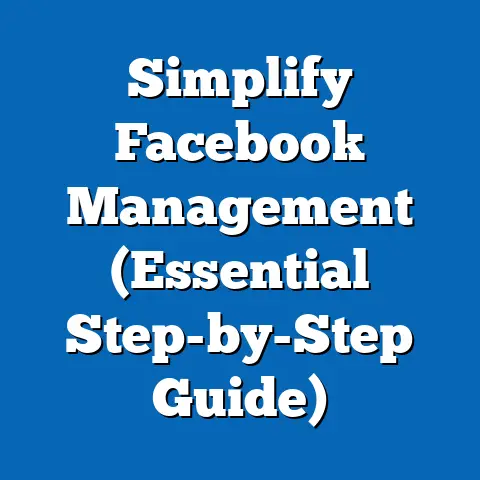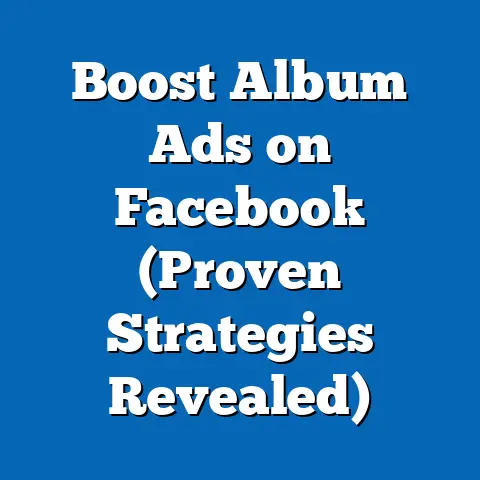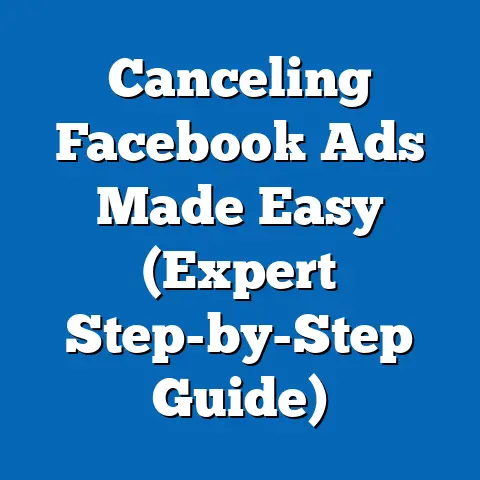Master Facebook Privacy Ads (Unlock Targeting Power)
Have you ever been scrolling through your Facebook feed and thought, “Wow, this ad is exactly what I was looking for?” Or maybe, “How did they know I was just talking about needing a new coffee maker?” It’s a common experience, and it often sparks a mix of wonder and maybe a little bit of unease. In today’s digital age, where data is king, the balance between effective advertising and user privacy is a tightrope walk.
I’ve spent years navigating the ever-changing landscape of Facebook advertising, and I’ve seen firsthand how brands can either build trust or erode it with their approach to targeting. This article isn’t just another guide on how to run Facebook ads; it’s a deep dive into how to do it right – ethically, responsibly, and effectively, all while respecting user privacy. We’ll explore the intricacies of Facebook’s privacy-focused advertising features, revealing how marketers can still harness the platform’s targeting power without compromising user trust.
Think of this as your comprehensive roadmap to mastering Facebook privacy ads. I’ll share my personal experiences, insights, and actionable strategies that have helped me and my clients achieve impressive results while staying on the right side of privacy. So, let’s get started and unlock the potential of privacy-respecting advertising on Facebook.
Section 1: Understanding Facebook’s Privacy Landscape
Before we dive into the nitty-gritty of ad creation and targeting, it’s crucial to understand the context in which we’re operating. User privacy is no longer a “nice-to-have” – it’s a fundamental expectation, and Facebook has had to adapt significantly over the years.
1.1 The Evolution of Privacy on Social Media:
Social media started as a fun way to connect with friends and family. Remember the early days of MySpace and Facebook? We were all eager to share our lives online, often without a second thought about who was watching. However, as these platforms grew, so did the concerns about how our data was being used.
- Early Days of Sharing: The initial focus was on connecting people, with less emphasis on data privacy.
- Rise of Data Concerns: As platforms matured, questions arose about how user data was being collected, stored, and used for advertising.
- Major Events: Events like the Cambridge Analytica scandal shook the world and forced Facebook to re-evaluate its privacy policies. I remember the uproar vividly – it was a wake-up call for both users and marketers.
Over the years, I’ve witnessed a significant shift in user attitudes towards privacy. People are more aware and more concerned, and they’re demanding greater control over their data. This heightened awareness has led to stricter regulations and increased pressure on social media platforms to prioritize user privacy.
1.2 Facebook’s Approach to User Privacy:
Facebook’s response to these growing concerns has been a series of changes and updates to its privacy policies and settings. The platform has introduced features that give users more control over their data, such as:
- Privacy Checkup: A tool that guides users through their privacy settings, allowing them to review and adjust who can see their posts, profile information, and more.
- Off-Facebook Activity: A feature that allows users to see and manage the data that businesses share with Facebook about their activity on other websites and apps. I’ve personally used this feature to disconnect my Facebook account from various apps I no longer use.
- Data Download: The ability for users to download a copy of their Facebook data, giving them a clear understanding of what the platform knows about them.
Facebook also provides detailed explanations of its data collection practices and how user consent is obtained. These explanations are often buried in lengthy privacy policies, but it’s essential for marketers to understand them.
- Data Collection: Facebook collects data from various sources, including user profiles, activity on the platform, and data shared by third-party websites and apps.
- User Consent: Facebook requires users to consent to the collection and use of their data, but the way this consent is obtained has been a subject of debate.
It’s worth noting that Facebook’s approach to user privacy is constantly evolving. The platform is continually adapting to new regulations and user expectations, so it’s crucial to stay informed about the latest changes.
1.3 The Importance of Trust in Advertising:
In the age of privacy concerns, user trust is more important than ever. People are more likely to engage with ads from brands they trust, and they’re more likely to share their data with companies that respect their privacy.
- Trust and Engagement: Studies have shown a direct correlation between user trust and ad engagement. People are more likely to click on ads from brands they perceive as trustworthy.
- Data Sharing: Users are more willing to share their data with companies that have a clear and transparent privacy policy. I’ve seen this firsthand – when clients are upfront about their data practices, users are more receptive to their ads.
- Consumer Attitudes: Statistics consistently show that consumers are increasingly concerned about their privacy and are more likely to support companies that prioritize it.
Building trust with your audience is not just the right thing to do; it’s also good for business. By respecting user privacy, you can create more effective ad campaigns and build long-term relationships with your customers.
Key Takeaway: Understanding Facebook’s privacy landscape is the foundation for running successful and ethical ad campaigns. By prioritizing user trust and staying informed about the latest privacy policies, you can build stronger relationships with your audience and achieve better results.
Next Steps:
- Familiarize yourself with Facebook’s privacy settings and data collection practices.
- Review your own ad campaigns to ensure they align with Facebook’s privacy policies and user expectations.
- Start thinking about how you can build trust with your audience through transparent data practices.
Section 2: Navigating Facebook’s Ad Tools in a Privacy-Centric World
Now that we have a solid understanding of the privacy landscape, let’s explore how to navigate Facebook’s ad tools in a way that respects user privacy while still achieving your marketing goals.
2.1 Introduction to Facebook Ads Manager:
Facebook Ads Manager is the central hub for creating, managing, and analyzing your ad campaigns. It’s a powerful tool, but it can also be overwhelming if you’re not familiar with its features.
- Interface Overview: The Ads Manager interface is divided into three main sections: Campaigns, Ad Sets, and Ads. Each section allows you to control different aspects of your campaigns.
- Key Features: Some of the key features of Ads Manager include audience targeting, budget setting, ad creation, and performance tracking. I’ve found the reporting features particularly useful for understanding how my campaigns are performing.
- Privacy-Conscious Advertising: When using Ads Manager, it’s essential to be mindful of privacy. This means carefully considering your targeting options, ad content, and data collection practices.
2.2 Audience Targeting Options:
Facebook offers a wide range of audience targeting options, allowing you to reach specific groups of people based on their demographics, interests, behaviors, and more. However, it’s crucial to use these options responsibly and ethically.
- Core Audiences: Core Audiences allow you to target people based on their demographics, interests, and behaviors. For example, you can target people who are interested in “sustainable living” or who have recently purchased a new car.
- Custom Audiences: Custom Audiences allow you to target people based on your own data, such as email lists or website visitors. However, it’s essential to obtain proper consent before using this data. I always recommend having a clear opt-in process for email lists and a transparent privacy policy on your website.
- Lookalike Audiences: Lookalike Audiences allow you to target people who are similar to your existing customers. This can be a powerful way to expand your reach, but it’s important to ensure that your source audience is privacy-compliant.
When using these targeting options, it’s essential to be transparent with your audience about why they’re seeing your ads. You can do this by including a clear and concise explanation in your ad copy.
Example: “You’re seeing this ad because you’re interested in sustainable living.”
This simple statement can go a long way in building trust with your audience.
2.3 Leveraging Facebook Pixel:
The Facebook Pixel is a small piece of code that you can install on your website to track user behavior. It allows you to measure the effectiveness of your ads, optimize your campaigns, and create custom audiences. However, it’s also a potential privacy risk if not implemented correctly.
- Pixel Functionality: The Pixel tracks various actions on your website, such as page views, button clicks, and purchases. This data can be used to create retargeting campaigns and optimize your ads for conversions.
- Best Practices: When implementing the Pixel, it’s essential to:
- Obtain user consent before tracking their behavior.
- Provide a clear and transparent privacy policy on your website.
- Use the Pixel data responsibly and ethically.
- Privacy Enhancements: Facebook has introduced several privacy enhancements for the Pixel, such as:
- Limited Data Use: Allows you to limit the data that is shared with Facebook.
- Aggregated Event Measurement: Allows you to measure the effectiveness of your ads without tracking individual users.
- Obtain user consent before tracking their behavior.
- Provide a clear and transparent privacy policy on your website.
- Use the Pixel data responsibly and ethically.
- Limited Data Use: Allows you to limit the data that is shared with Facebook.
- Aggregated Event Measurement: Allows you to measure the effectiveness of your ads without tracking individual users.
I’ve found that using these privacy enhancements can significantly improve user trust and ad performance.
Key Takeaway: Facebook Ads Manager offers a range of powerful targeting options, but it’s crucial to use them responsibly and ethically. By being transparent with your audience and implementing privacy enhancements, you can build trust and achieve better results.
Next Steps:
- Review your current ad campaigns to ensure they’re using targeting options responsibly.
- Implement privacy enhancements for the Facebook Pixel on your website.
- Create a clear and transparent privacy policy on your website.
Section 3: Crafting Privacy-Respecting Ads
Now that we’ve covered the technical aspects of Facebook advertising, let’s dive into the creative side. Crafting ads that respect user privacy is not just about following the rules; it’s about building trust and creating meaningful connections with your audience.
3.1 Creating Compelling Ad Content:
The content of your ads is just as important as your targeting options. You need to create ad copy that resonates with users while respecting their privacy.
- Focus on Value: Instead of focusing on intrusive targeting, focus on the value you’re offering to your audience. Highlight the benefits of your product or service and how it can solve their problems. I always start by thinking about what my audience truly needs and how I can help them.
- Use Clear and Concise Language: Avoid using jargon or technical terms that your audience may not understand. Use clear and concise language that is easy to read and understand.
- Be Transparent: Be upfront about your data practices and why users are seeing your ads. This can help build trust and increase engagement.
- Avoid Personalization Pitfalls: Be cautious about using highly personalized language or imagery that could make users feel like their privacy is being invaded.
Example: Instead of saying, “We know you’re interested in running shoes,” try saying, “Check out our latest collection of running shoes.”
I’ve found that subtle changes in language can make a big difference in how users perceive your ads.
3.2 Visual Elements and User Engagement:
Visual elements play a crucial role in capturing attention and driving engagement. However, it’s important to use visuals that are relevant, engaging, and respectful of user privacy.
- Use High-Quality Images and Videos: Use high-quality images and videos that are visually appealing and relevant to your target audience. Avoid using stock photos that look generic or staged.
- Tell a Story: Use visuals to tell a story that resonates with your audience. This can help create an emotional connection and increase engagement.
- Avoid Intrusive Visuals: Be cautious about using visuals that could be perceived as intrusive or creepy. For example, avoid using images that show people in compromising situations or that are overly suggestive.
- Ensure Accessibility: Make sure your visuals are accessible to people with disabilities. This includes providing alt text for images and captions for videos.
I’ve seen firsthand how powerful visual storytelling can be in Facebook ads. By using authentic and engaging visuals, you can capture attention and build trust with your audience.
3.3 Ad Formats That Work Well with Privacy Measures:
Facebook offers a variety of ad formats, each with its own strengths and weaknesses. Some ad formats are better suited for privacy-conscious advertising than others.
- Image Ads: Image ads are a simple and effective way to capture attention and convey your message. They’re also relatively privacy-friendly, as they don’t require a lot of personal data.
- Video Ads: Video ads are a powerful way to tell a story and engage your audience. However, it’s important to use videos that are relevant and respectful of user privacy.
- Carousel Ads: Carousel ads allow you to showcase multiple images or videos in a single ad. This can be a great way to highlight different aspects of your product or service.
- Collection Ads: Collection ads are designed to showcase products in a visually appealing way. They’re particularly well-suited for e-commerce businesses.
I’ve found that carousel ads and collection ads are particularly effective for privacy-conscious advertising, as they allow you to showcase your products or services without being overly intrusive.
Key Takeaway: Crafting privacy-respecting ads is about more than just following the rules; it’s about building trust and creating meaningful connections with your audience. By focusing on value, using clear language, and avoiding intrusive visuals, you can create ads that resonate with users and drive results.
Next Steps:
- Review your current ad content to ensure it’s privacy-respecting.
- Experiment with different ad formats to see which ones work best for your audience.
- Focus on creating high-quality visuals that tell a story and engage your audience.
Section 4: Measuring Success While Respecting User Privacy
Measuring the success of your Facebook ad campaigns is essential, but it’s also important to do it in a way that respects user privacy. This means focusing on metrics that are privacy-friendly and avoiding those that rely on intrusive tracking.
4.1 Key Performance Indicators (KPIs) for Privacy-Focused Ads:
Traditional KPIs like click-through rate (CTR) and conversion rate are still important, but they shouldn’t be the only metrics you track. Here are some other KPIs that are particularly relevant for privacy-focused ads:
- Reach: The number of unique people who saw your ad. This is a good indicator of how well your ad is reaching your target audience.
- Engagement: The number of likes, comments, and shares your ad received. This is a good indicator of how well your ad is resonating with your audience.
- Brand Awareness: The extent to which your ad is increasing awareness of your brand. This can be measured through surveys, social listening, and website traffic.
- Return on Ad Spend (ROAS): The amount of revenue you generate for every dollar you spend on advertising. This is a key indicator of the overall effectiveness of your ad campaigns.
I’ve found that focusing on these KPIs can help you get a more holistic view of your ad performance while respecting user privacy.
Example: Instead of focusing solely on conversion rate, consider tracking reach, engagement, and brand awareness to get a better understanding of how your ads are impacting your audience.
4.2 A/B Testing in a Privacy-Conscious Environment:
A/B testing is a powerful way to optimize your ad campaigns, but it’s important to do it in a way that doesn’t compromise user privacy.
- Use Aggregated Data: Instead of tracking individual user behavior, use aggregated data to compare the performance of different ad variations.
- Focus on High-Level Metrics: Focus on high-level metrics like reach, engagement, and ROAS, rather than granular metrics like click-through rate.
- Be Transparent: Be transparent with your audience about why you’re running A/B tests and how you’re using their data.
I’ve successfully used A/B testing to optimize my ad campaigns without compromising user privacy by focusing on aggregated data and high-level metrics.
4.3 Adjusting Strategies Based on Data Insights:
The data you collect from your ad campaigns can provide valuable insights into what’s working and what’s not. However, it’s important to interpret this data responsibly and ethically.
- Focus on Trends: Instead of focusing on individual data points, look for trends and patterns in your data. This can help you identify areas where you can improve your ad campaigns.
- Consider Context: Consider the context in which your data was collected. For example, if you’re running ads during a holiday season, your results may be different than if you’re running ads during a slow period.
- Be Open to Experimentation: Be open to experimenting with different ad strategies based on your data insights. This can help you find new and innovative ways to reach your target audience.
I’ve learned that the key to successful data analysis is to be curious, open-minded, and willing to experiment. By embracing this approach, you can unlock valuable insights that can help you improve your ad campaigns and achieve your marketing goals.
Key Takeaway: Measuring the success of your Facebook ad campaigns is essential, but it’s important to do it in a way that respects user privacy. By focusing on privacy-friendly KPIs, using aggregated data for A/B testing, and interpreting data responsibly, you can optimize your ad campaigns without compromising user trust.
Next Steps:
- Review your current KPIs to ensure they’re privacy-friendly.
- Implement aggregated data for A/B testing.
- Develop a data-driven approach to optimizing your ad campaigns.
Section 5: Future Trends in Facebook Advertising and Privacy
The world of Facebook advertising and privacy is constantly evolving. It’s important to stay informed about the latest trends and developments so you can adapt your strategies accordingly.
5.1 The Role of AI and Machine Learning:
AI and machine learning are playing an increasingly important role in Facebook advertising. These technologies can be used to:
- Automate Ad Creation: AI can help you create ad copy and visuals that are more engaging and relevant to your target audience.
- Optimize Targeting: Machine learning can help you identify the most effective targeting options for your ad campaigns.
- Personalize Ad Experiences: AI can help you personalize ad experiences for individual users, making them more likely to engage with your ads.
However, it’s important to use AI and machine learning responsibly and ethically. This means ensuring that these technologies are not used to discriminate against certain groups of people or to manipulate users into making decisions they wouldn’t otherwise make.
I believe that AI has the potential to transform Facebook advertising, but it’s crucial to use it in a way that respects user privacy and promotes ethical practices.
5.2 Regulatory Changes and Their Impact:
Regulatory changes are having a significant impact on Facebook advertising. New privacy laws like the General Data Protection Regulation (GDPR) and the California Consumer Privacy Act (CCPA) are giving users more control over their data and are making it more difficult for advertisers to track user behavior.
To comply with these regulations, advertisers need to:
- Obtain User Consent: Obtain explicit consent from users before collecting their data.
- Provide Transparency: Provide users with clear and transparent information about how their data is being used.
- Respect User Rights: Respect users’ rights to access, correct, and delete their data.
I’ve found that complying with these regulations is not only the right thing to do, but it’s also good for business. By respecting user privacy, you can build trust and create stronger relationships with your audience.
5.3 The Shift Towards Ethical Advertising:
There’s a growing trend towards ethical advertising. Consumers are increasingly demanding that brands be transparent, honest, and respectful of their privacy.
To embrace ethical advertising, brands need to:
- Be Transparent: Be transparent about their data practices and advertising strategies.
- Be Honest: Be honest about the products and services they’re advertising.
- Be Respectful: Be respectful of user privacy and avoid using manipulative or deceptive tactics.
I believe that ethical advertising is the future of marketing. By embracing ethical practices, you can build trust, create stronger relationships with your audience, and achieve long-term success.
Key Takeaway: The future of Facebook advertising is being shaped by AI, regulatory changes, and a growing demand for ethical practices. By staying informed about these trends and adapting your strategies accordingly, you can thrive in the ever-changing world of digital marketing.
Next Steps:
- Explore how AI and machine learning can be used to improve your ad campaigns.
- Stay informed about the latest regulatory changes and how they impact your advertising strategies.
- Embrace ethical advertising practices to build trust and create stronger relationships with your audience.
Conclusion:
We’ve covered a lot of ground in this article, from understanding Facebook’s privacy landscape to crafting privacy-respecting ads and measuring success while respecting user privacy. The key takeaway is that balancing effective targeting with user privacy is not just a responsibility; it’s an opportunity to build trust, create stronger relationships with your audience, and achieve long-term success.
I encourage you to rethink your approach to Facebook ads, prioritizing user trust and ethical practices in your marketing strategies. By doing so, you can not only comply with regulations and build stronger relationships with your audience, but also unlock new levels of creativity and innovation in your ad campaigns. The world of Facebook advertising is constantly evolving, but one thing remains constant: the importance of respecting user privacy and building trust with your audience. So go forth, create amazing ads, and make the world a better place, one privacy-respecting campaign at a time!






